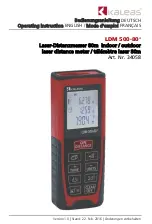
SWR-584C Instruction Manual
HF/VHF/220MHz SWR Analyzer
4
1.5 Calibration Plane:
Your analyzer's
Calibration Plane
is the point of reference where all
measurements have greatest accuracy
(Gain Reference = 0dB
and
Phase Shift = 0 degrees)
.
For basic handheld units like the SWR-584C, the calibration plane is always
fixed at the
analyzer's RF connector
. Any time a transmission line is installed between the analyzer's RF
connector and an item being tested, the cable will displace the load from the calibration plane
and introduce some form of measurement transformation.
For SWR measurement, installing lengths of feedline usually causes a slight reduction in
readings caused by attenuation losses. Unless the cable losses are high, the difference is
usually insignificant. However, when documenting the performance of a new antenna design or
network device, the analyzer should always be connected as close to the load as possible to
minimize padding down of SWR readings.
Displacement of the calibration plane becomes far more significant when measuring
impedance because of phase rotation and transformer action occurring in the feedline. In fact,
impedance readings may swing dramatically, depending on the cable's electrical length and
the severity of the load's mismatch referenced to 50 Ohms. To collect meaningful impedance
data for a device,
always connect the analyzer directly -- using the shortest cable possible.
1.6 Reactance Sign Ambiguity:
Most handheld analyzers, including the SWR-584C, lack
the data processing capability required to calculate
Reactance Sign.
These signs are (
+)
for
inductive reactance
X
L
and (
-
) for capacitive reactance
Xc
. In most cases, you can apply one
or more simple tests to determine sign. See specific measurement instructions for details.
1.7 Protecting Your Analyzer:
To minimize measurement error at high frequencies, the
analyzer's detector diodes are installed directly at the antenna port. Be aware that applying
any
external potential
exceeding a few volts of RF, AC, DC, or ESD energy could cause damage.
Caution and common sense are the best protections against failure. Never connect a
transmitter to the
Antenna
jack, and when testing ungrounded antenna systems that could
accumulate a static charge, always short the connector before attaching it to the analyzer.
Short Antenna
Leads to Discharge
Static Before
Connecting!
Important Warning: Never applying an external voltage to the Antenna jack -- it could
damage sensitive detector diodes. Also, always discharge the coax connector to bleed
off static before attaching ungrounded arrays.





































